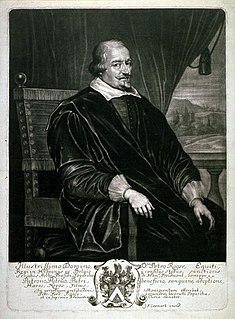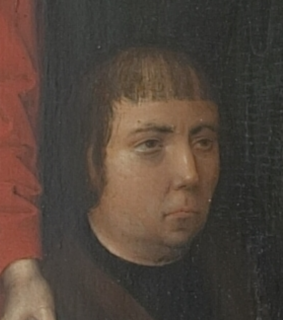Related Research Articles
Michiel Coxie the Elder, Michiel Coxcie the Elder or Michiel van Coxcie, Latinised name Coxius, was a Flemish painter of altarpieces and portraits, a draughtsman and a designer of stained-glass windows, tapestries and prints. He worked for patrons in the principal cities of Flanders. He became the court painter to successively Emperor Charles V and King Philip II of Spain.

In the history of the Low Countries, the Burgundian Netherlands were a number of Imperial and French fiefs ruled in personal union by the House of Valois-Burgundy in the period from 1384 to 1482 and later their Habsburg heirs. They constituted the Northern part of the Burgundian State. The area comprised the major parts of present-day Belgium, Netherlands, Luxembourg and Hauts-de-France.

From the 15th century onwards, the Great Council of the Netherlands at Mechelen was the highest court in the Burgundian Netherlands. It was responsible for the Dutch-, French- and German-speaking areas. In Luxembourgish the phrase "mir ginn op Mechelen" still means playing one's last trump card. The Grote Raad first sat in the Schepenhuis in Mechelen then, from 1616, in the (old) palace of Margaretha of Austria on Keizerstraat.

Pieter Roose, lord of Froidmont, Han and Jemeppe, was president of the Privy Council from 1632 to 1653, and a key actor in the government of the Habsburg Netherlands for over twenty years.

Engelbert Maes (1545–1630), was chief-president of the Privy Council of the Habsburg Netherlands and Council of State from 1614 to 1630, making him a central figure in the government of the Habsburg Netherlands for sixteen years.

Remi Drieux, Latinized Remigius Driutius (1519–1594) was the first bishop of Leeuwarden and the second bishop of Bruges.

The Privy Council or Secret Council was one of the three "collateral councils" that together formed the highest government institutions of the Habsburg Netherlands. Bseed in Brussels, it was particularly charged with legal and administrative questions.
Jean Alphonse, 1st Count de Coloma, was a Flemish noble lord of Spanish descent, a member of the House of Coloma. He was a councillor on the Great Council of Mechelen and the supreme council in Vienna, and president of the Privy Council of the Habsburg Netherlands .
Philippe-Guillaume de Steenhuys, 1st baron of Poederlee and lord of Flers, Heerle, Gierle, Moerbeke, etc., was an office-holder in the Spanish Netherlands who served on the Great Council of Mechelen, the Council of Flanders, and the Brussels Privy Council.
Christophe-Ernest, 1st Count of Baillet (1668-1732) was a leading figure in the government of the Austrian Netherlands.

Mathias Lambrecht (1539–1602) was the third bishop of Bruges.

Guillaume de Grysperre (1543/4–1622) was a jurist who became a member of the Brussels Privy Council.

Filips Wielant (1441/2–1520) was a magistrate and legal theorist in the Burgundian Netherlands, and a participant in the Flemish revolts against Maximilian of Austria.
Guillaume de Pamele or Willem van Pamele (1528–1591) was a royal office-holder in the Habsburg Netherlands during the Dutch Revolt. He served as president of the Council of Flanders and of the Privy Council of the Habsburg Netherlands.
Adrien van der Burch (1501–1557) was an office-holder in the Habsburg Netherlands.
Lambert van der Burch (1542–1617) was a clergyman and historian from the Habsburg Netherlands.
Jean de Glymes de Berghes or Jan van Bergen, Lord of Waterdijk, was an officeholder in the Habsburg Netherlands.

Franciscus van der Burch (1567–1644) was a bishop of Ghent and archbishop of Cambrai.

Albert de Coxie, baron of Moorseele, lord of Bouseval, la Tour, etc., was a jurist who became president of the Privy Council of the Habsburg Netherlands.
Guillaume-Philippe, marquis d'Herzelles (1642–1698), baron of Werchin and Liedekerke, lord of Facuwez, was a magistrate and statesman in the Habsburg Netherlands.
References
- 1 2 3 General Guillaume, "Burch (Jean Vander)", Biographie Nationale de Belgique , vol. 3 (Brussels, 1872), 160-161.